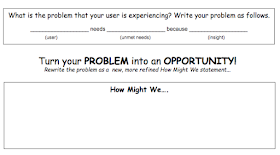The idea is when students are engaged in their own progress they will be building their 21st Century skills.
Design thinking
I have been doing design thinking myself in my teacher inquiry and this is what Ormiston is doing for their iExplore time.
The process involves:
- Identifying a need or opportunity to solve a problem
- Learning about the problem and people affected
- Brainstorming lots of potential solutions
- Making a prototype
- Getting feedback
- Modifying the prototype
- Repeating this process several times.
Students who were here talked about their passion project being how to teach others Empathy. They created video and other content to help others.
Example:
Problem:
How to get the children tidying up the classroom faster.
Why is it a problem:
So that we don’t waste as much time at the end of the day.
The Five Whys..
I have talked about the five whys in my own Inquiry. This is where as a buddy you as five why questions about the problem.
For this they used a clear grid and worked in pairs. A why question might be why does it take so long to tidy up? this might lead to the answer students are talking. Why are they talking etc.
I find it interesting they are using this design thinking process with kids. I know it has been successful for me as a adult. I would like to try this with my kids.
Half of the time is spent on thinking about the problem and the thinking behind it. It is a long game and the thing they create is not as important as the process.
Empathy profile-Empathy is at the heart of the design thinking process. The learners have to put themselves in the shoes of the person/people whose actions you are trying to change.
This is the template they use:
The children would go in the middle of this template. Then around the outside I would be identifying why the children mess around instead of tidying up and what motivates them to do this.
Student then act as the person in their profile this helps them to connect and understand the problem.
We use HOW MIGHT WE..... Question in inquiry. You can have a whole lesson on questions. Writing good questions is an important part of the learning for our kids. It is so important that the question is specific and answerable. Big question don't help our learners.
How might we speed up the process of tidying so we can save time in our day?
They then publish their problems with a picture of themself and print them to put in the wall.
Remember: Fall in Love with the Problem NOT the solution.
It is about always bring the focus back to the problem. Having the problem visible helps to the kids to keep coming back to your problems.
In this activity, is like the crazy 8s you can see in this blog post. They say that they give them 40 sec for each square. You can give them ideas if they get really stuck.
Once they focus on one or some idea form a plan and get feedback on your storyboard.
They then list every single step they are going to take on a post it note. Then they put it in order of what they are going to do. They students who do this well had a much more successful process.
They begin prototyping. Revising their prototype and considering how this will look in its finished form. They get feedback from others to help them develop their prototype.
They then think how will be share our project?
Feedback-They have their feedback grid which they use to get feedback on their project.
One of the great things I have noticed about this process is the huge amount of feedback.





No comments:
Post a Comment